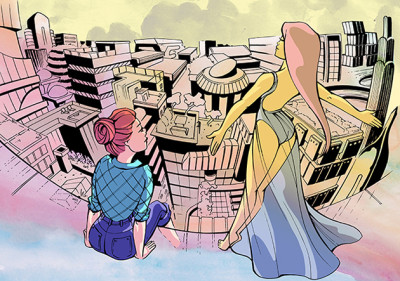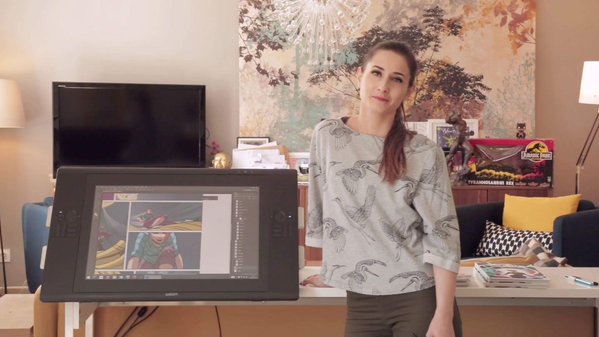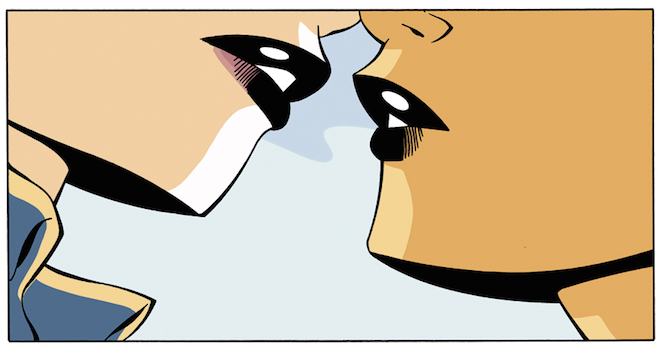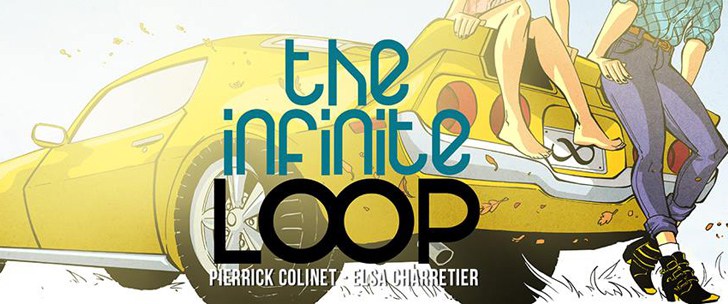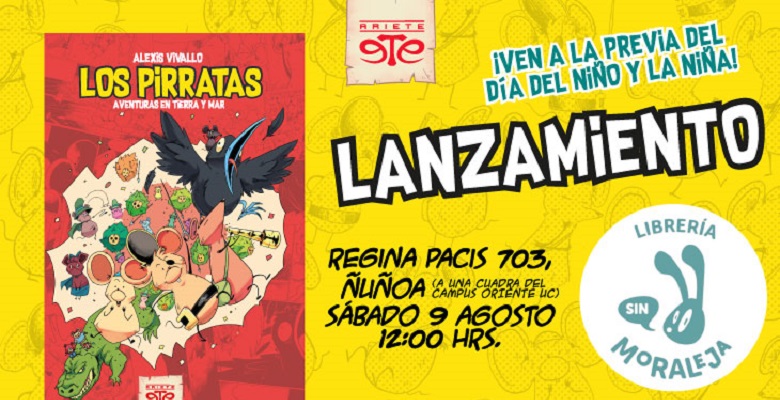An Interview with Elsa Charretier: «I hope this book will reach to young LGBT, still trying to figure out their life, their sexuality»
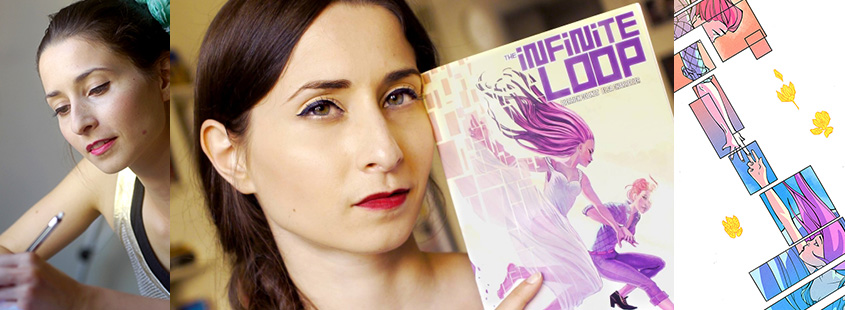
This year, IDW Publishing published The Infinite Loop by the french Pierrick Colinet in the script and Elsa Charretier in the drawings and I fell in love. By seeing the cover of the first issue I said, "Here's something like a Bruce Timm influence ... I must read it!" and the story was just great and I ended up falling in love with the comic and the characters. Two women are destined to love each other but in the way they see all kinds of conflicts and obstacles. The Infinite Loop is a weapon for the inclusion of the LGBT community (Lesbian, Bisexual, Gay and Transgender) who just want to show that love has no form or gender.
It is with profound pleasure that I invite you to the interview I did to Elsa Charretier, co-author and artist of The Infinite Loop, who tells us how the project was born, her preferences and some of her future projects that I look forward to.
Joaquín Bustamante: First of all, congrats on The Infinite Loop. It's a hell of a story, I'd like to start here. Doing a little research for this interview, I learned that it started as a crowdfunding project. Can you tell me something about that? How did The Infinite Loop happened?
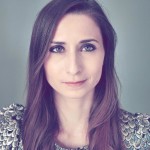 Elsa Charretier: Thank you very much. The Infinite Loop means a lot to us, so I really appreciate the nice words. It's actually a book that first got turned down by a couple of french editors. About 2 1/2 years ago, we pitched them the book, did the five pages, but they thought it wasn't good enough . They were right actually. The story was 12 issues long, so way too ambitious for a first time writer, and my own artwork wasn't ready. I had just switched to a more cartoony style, and it clearly needed some work. So, when The Infinite Loop got rejected, we did another book with a smaller publisher. When that was done and that we both found ourselves without a job, we decided to find a way to make The Infinite Loop happen. During the previous year, the characters kind of stuck with us. Teddy and Ano were there and we wanted to tell their story. And the book being about such a sensitive subject, LBGT civil rights —in France we just had the whole debate about gay marriage, and it turned out there were a lot more homophobic people than we thought—, we were afraid a publisher might want to "polish" what we wanted to say. Crowdfunding quickly became the right solution to fund this book.
Elsa Charretier: Thank you very much. The Infinite Loop means a lot to us, so I really appreciate the nice words. It's actually a book that first got turned down by a couple of french editors. About 2 1/2 years ago, we pitched them the book, did the five pages, but they thought it wasn't good enough . They were right actually. The story was 12 issues long, so way too ambitious for a first time writer, and my own artwork wasn't ready. I had just switched to a more cartoony style, and it clearly needed some work. So, when The Infinite Loop got rejected, we did another book with a smaller publisher. When that was done and that we both found ourselves without a job, we decided to find a way to make The Infinite Loop happen. During the previous year, the characters kind of stuck with us. Teddy and Ano were there and we wanted to tell their story. And the book being about such a sensitive subject, LBGT civil rights —in France we just had the whole debate about gay marriage, and it turned out there were a lot more homophobic people than we thought—, we were afraid a publisher might want to "polish" what we wanted to say. Crowdfunding quickly became the right solution to fund this book.
JB: And how did you went from a crowdfunding project to be published by IDW?
EC: That's kind of a nice story. During the crowdfunding campaign, Mike Federali at Robot 6 did a story about how Charlie Adlard is amazing and how he helped us starting out. That lead to another interview, in Janelle Asselin's "Hire this Woman" column on Comics Alliance. Sarah Gaydos, which is now our editor at IDW, saw it, and reached out to us, saying she liked what she saw, wanting to know more. After reading #1, she seemed interested, so, on an impulse, we booked plane tickets to New York Comic Con to pitch her the book in person. They loved it, and now the book comes out as a trade, so I guess things went pretty well! Really, this book happened thanks to a lot of people.
Editor's Note: The interview "Hire this Woman" was dedicated to Elsa Charretier and her job in The Infinite Loop. You can check it out here.
JB: And what does The Infinite Loop means to you? As a book and as an experience? Is your personality as colorful and dynamic as your art in the pages?
EC: The Infinite Loop is and will alway be our baby. It took us such hard work to get it out there that we have this special connection to it. Teddy and Ano —although I'm aware they are fictional characters— are our two girls, and we love them! Crowdfunding this book basically taught us everything we now know. Whether it's how to tell a good story, how to handle all the aspects of production, how to promote a book, how to meet deadlines...
As for whether I am as colorful and dynamic as my art, I guess we all put ourselves in our work in some ways. I do know that I'm a positive person and that I have a lot of energy!
JB: When did you decided to become an artist? How was that process?
EC: Pierrick and I have known each other for a long time, and we used to work in the entertainment industry —I was an actress and he was a writer—, but we both felt miserable. I’ve always been interested in art, but acting wasn't the right way to express myself. And I think Pierrick was feeling the same. Around that time, he discovered comics and starting to work on a story on his own. Until he met Charlie Adlard at a convention in France. Charlie didn’t have much time to chat but he gave him his email. Pierrick emailed him, without much hope… But a few weeks later, Charlie got back to him, saying he’d be back in France in a couple weeks and would love to take a look at Pierick's project.
Only Pierrick didn’t really have a project. No artist, no pages, just a plot. And so, he asked me — me, who had never drawn, and who didn’t really know anything about comics — “Do you think you can learn how to draw in two weeks ?”. I had nothing to lose so I said yes. I thought that, worst case scenario, Charlie would just laugh at us. And he didn't! Although the pages looked terrible, he spent an hour with us, explaining how I could improve the pages, how to learn anatomy, how to properly tell a story…
So in a sense, Charlie was the starting point of our careers.
JB: How would you describe your creative style? What are your essential tools to draw?
EC: I drew and inked my pages traditionally for the first 3 issues of The Infinite Loop. After that, I bought a Cintiq and now work 100% digital. It's way faster, and I think I'm more creative. My work looks better overall.
As for my creative style... I'm really into animation, and I try to apply the basics to my work. Movement, body language…
JB: I gotta confess to you. When I first looked at The Infinite Loop #001 cover my first though was "OMG, this art looks kinda Bruce Timm-ish. or Darwyn Cooke-ish. I must read it" and I fell in love with your work, the story and the Teddy-Ano relationship. Was Timm an influence in your work in general? And what about Cooke? Who are your favorite artists?
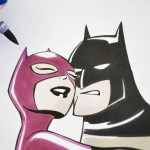 EC: I grew up watching Batman: The Animated Series, and it had a great impact on me. So, yes Bruce Timm is definitely an influence. Darwyn Cooke, on the other hand, I discovered his work pretty recently. We must have the same influences I guess! There was this studio in the '40s, the Fleischer Studios, which were famous for their human characters —the other studios worked mainly on animals characters—. And their work had a great influence on animation, for decades to come.
EC: I grew up watching Batman: The Animated Series, and it had a great impact on me. So, yes Bruce Timm is definitely an influence. Darwyn Cooke, on the other hand, I discovered his work pretty recently. We must have the same influences I guess! There was this studio in the '40s, the Fleischer Studios, which were famous for their human characters —the other studios worked mainly on animals characters—. And their work had a great influence on animation, for decades to come.
JB: And your favorite writers?
EC: I really really like Matt Fraction's work. I haven't tried so far to understand why he is so good, but when I start reading one of his books, I can't put it down until I finish it.
JB: What do you know about Chile? Have you read any latin american comics?
EC: I know the country, of course, but don't read latin american comics, I'm afraid. I've read work from latin creators, that's for sure. Lots of talented people! And I would really love to go to Chile, one day. I've never been to South America!
JB: Do you have a favorite subject you'd like to 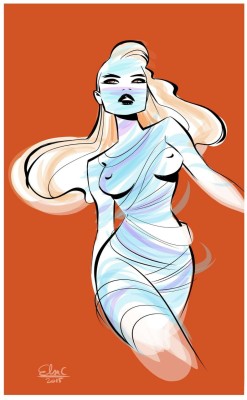 write/draw about? Or superhero? What would you like to write about?
write/draw about? Or superhero? What would you like to write about?
EC: I don't think writing is for me, so I'll stick to drawing, at least for now. I recently started thinking about what I liked drawing, what kind of project would passionate me enough that I can work on for months without getting bored. And I think for me it's all about the characters. Of course, the plot has to be interesting, but the characters are really what matters to me. I have to feel this connexion with them. That's why I'm really careful during the design stages, because if I'm not fond of the design itself, the shapes of the characters, the range of their facial expressions, my hand literally gets bored.
JB: Which comics are you currently reading? Why? Is it the creators, the premise, the art or something else?
EC: I bought tons of books recently, and I've yet to read them. Southern Bastard, Descender, Gotham Academy, This One summer, Black Science… Mainly Image titles, or indie comics. With comicbook related websites, you know pretty much in advance which title is good. When I like the art, I buy them. I sometimes buy books whose art I don't like. But I have to be sure the writing is excellent. And I try to broaden my horizons, although I must admit it's really hard. Go for books I wouldn't have picked up, and discover new things.
JB: Do you feel the recent changes in the comic world, such as the new Batgirl image [by Cameron Stewart], or Ms. Marvel, etc. are positive and modern changes or are they missing something?
EC: I think it's fantastic. Especially the new Batgirl, Ms. Marvel, and Harley Quinn, which are the three titles that kind of set the tone. It's young, and refreshing, but more importantly, it's GOOD. I'm all for creating fun titles —enough with the gritty stuff already!— that will attract younger readers, as long as it's not becoming another trend. What I mean by that is we shouldn't fall in the trap of doing the same teenagers stuff over and over again without paying attention to the content. Because, and I think it's happening with a few DC YOU series, younger readers —and readers in general— are not stupid. They want quality books. Otherwise, you can draw as many selfies as you want, it won't sell!
JB: What are your favorite comic books? Those that you must have in your collection, standing there in your bookshelf.
EC: There are so many. I have stacks of books next to my bed. Right now, I'm catching up on Locke & Key. Once you start, you can't put this book down.
JB: I want to get a little into The Infinite Loop and what does it mean as a feminist story and a LGBT love story. How do you feel to be able to put a story like this in such a massive media like comics? Did you and Pierrick felt the need to tell a love story like this? Why everybody should read The Infinite Loop?
EC: In The Infinite Loop we talk about how difficult it is to blossom and live a happy life when you're forbidden to love freely. Our two characters are lesbians, so we're fighting for gay rights, but not only. We're talking about how people who were/are considered incompatible in the eyes of the society were/are discriminated. And more importantly, how society keeps repeating this same pattern over and over again.
I hope this book will reach to young LGBT, still trying to figure out their life, their sexuality. There are people fighting for their rights out there, and it's important for them to see they're not alone. We also hope this book will reach non-LGBT readers. When you don't have any gay friends of family members, it can be hard to imagine the difficulties they will facing during their lives. I hope our book participate in raising awareness.
JB: Did you watch the Legend of Korra finale? How do you feel about this? Is this the time when young and bold artists, like you, can make the world learn that true love doesn't have shape, form or sex?
EC: Friends told me about it, but I'm afraid I haven't seen it myself. But I will!
There are still lots of discrimination out there unfortunately, but it seems like the new generation is more open to this idea. It might probably take a while to get to the point when everybody's accepted for who they are, but I'm confident we'll get there. Eventually.
JB: In children's TV networks, and animated series in particular, there still exists a taboo to talk about and openly depict LGBT relationships in the plot. For example, in the Legend of Korra finale, [spoilers] we see Korra and Asami assuming a very couple-ish partner position but it doesn't quite close the deal. Do you think that series like The Infinite Loop will help make TV networks to start creating animated series with stories more openly inclusive, so children will learn to understand and accept their own sexialities?
EC: I won't go as far as saying we're going to change the future of children's TV programs, haha, but we're part of a whole new generation of creators who wants to talk about LGBT love. Over time, I hope, with more and more shows featuring gay/trans characters, it'll be less "complicated" for networks to have them. I think it's absolutely necessary that we get there at some point. TV, books, can be a huge help to kids to understand certain aspects of life they're having a hard time apprehending. And for their parents too! Having a gay child to some families can be difficult to deal with, because sometimes people feel uncomfortable talking about sexuality — especially when it comes to their kids. TV programs/books can be such great tools to help communication between parents and children.
JB: What do you have in store for the future? Any new projects that you want to tease your fans with?
EC: Right now I'm working on a graphic novel with George R.R. Martin, and it's tons of fun. I still have months of work left to do, but after that, a couple of exciting stuff are lining up. I'm really excited!
JB: Any words for our readers? Maybe something to motivate them to read The Infinite Loop?
EC: We really poured our heart and soul on this book. Teddy and Ano will be forever our two firsts characters, our two girls, and I'll hope you'll like them as much as we do!

